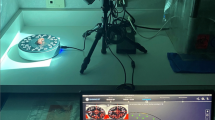Abstract
Purpose
To explore an accurate radiologic–pathologic control method in soft tissue tumor.
Materials and methods
First, we performed a preliminary experimental study of the radiologic–pathologic control method in soft tissue mass simulation model. Targeted localization markers were performed during MRI, surgery, and pathology, to ensure accurate correspondence between MRI slices and pathological sections. And the MRI image after printing was matched with the pathological material surface to obtain the pathological material corresponding to the region of interest (ROI). Second, we performed the same method on soft tissue tumor clinical research population. The long and short diameters of the tumor MRI slices and pathological sections were measured. A paired t test was used to assess differences between them.
Result
A paired t test showed that there were no signifacant differences of the length and diameter of the simulation tumor measured between MRI slices and pathological sections in soft tissue tumor simulation model and clinical research population (p > 0.05).
Conclusion
The “Body position line-MRI slice-Pathological section Five-step Control Method” created by this study could carry out a more accurate radiologic–pathologic comparison study in soft tissue tumors.



Similar content being viewed by others
References
Heitzman R. Bronchogenic carcinoma: radiologic-pathologic correlations. Semin Roentgenol. 1977;12(3):165–74.
Mendelson EB, Harris KM, Doshi N, et al. Infiltrating lobular carcinoma mammographic patterns with pathologic correlation. AJR Am J Roentgenol. 1989;153(2):265–71.
Kalli S, Lanfranchi M, Alexander A, et al. Spectrum of extramammary malignant neoplasms in the breast with radiologic-pathologic correlation. Curr Probol Diaon Radiol. 2016;45(6):392–401.
Caplan A. Correlation of radiological category with lung pathology in coal-workers pneumoconiosis. Occup Environ Med. 1962;19(3):171–9.
Messinger NH, Beneventano TC, Siegelman SS. Interflexural carcinoma of the colon clinical radiologic pathologic correlations. Dis Colon Rectum. 1971;14(4):255–8.
Sato T, Sakai Y, Kajita A, et al. Radiographic microstructures of early esophageal carcinoma correlation of specimen radiography with pathologic findings and clinical radiography. Gastro Intest Radiol. 1986;11(1):12–9.
Leung AN, Miller PR, Muller NL. Parenchymal opacification in chronic infiltrative lung diseases CT-pathologic correlation. Radiology. 1993;188(1):209–14.
Bush CH, Reith JD, Spanier SS. Mineralization in musculoskeletal leiomyosarcoma radiologic-pathologic correlation. AJR Am J Roentqenol. 2003;180(1):109–13.
Li Q, Fan X, Huang XT, et al. Tree in bud pattern in central lung cancer CT findings and pathologic correlation. Lung Cancer. 2015;88(3):260–6.
Hartman DS, Davis CJ, Goldman SM, et al. Renal lymphoma radiologic-pathologic correlation of 21 cases. Radiology. 1982;144(9):759–66.
Yoon SK, Nam KJ, Rha SH, et al. Collecting duc tcarcinomaof the kidney CT and pathologic correlation. Eur J Radiol. 2006;57(3):453–60.
Berniker AV, Abdulrahman AA, Teytelboym OM, et al. Extrapulmonary small cell carcinoma imaging features with radiologic pathologic correlation. Radiology. 2015;35(1):152–63.
Yang Z, Sone S, Takashima S, et al. Small peripheral carcinomas of the lung thinsection CT and pathologic correlation. Eur Radiol. 1999;9(9):1819–25.
Trimble CR, Burke A, Kliqerman S. Primary cardiac osteosarcoma: AIRP best cases in radiologic-pathologic correlation. Radiographics. 2015;35(5):1352–7.
Isebaert S, Van den Bergh L, Haustermans K, et al. Multiparametric MRI for prostate cancer localization in correlation to whole mount histopathology. J Magn Reson Imaging. 2013;37(6):1392–401.
Posniak HV, Olson MC, Dudiak CM, et al. MR imaging of uterine carcinoma correlation with clinical and pathologic findings. Radio Graphics. 1990;10(1):15–27.
Murphey MD, Ruble CM, Tyszko SM, et al. From the archives of the AFIP musculoskeletal fibromatoses: radiologic-pathologic correlation. Radiographics. 2009;29:2143–76.
Kinner S, Schubert TB, Nocerino EA, et al. MR visible localization device for radiographic-pathologic correlation of surgical specimens. Maqn Reson Imaging. 2017;37:157–63.
Jiang S, Charles G, Zhang Y, et al. Amide proton transfer-weighted magnetic resonance image-guided stereotactic biopsy in patients with newly diagnosed gliomas. Eur J Cancer. 2017;83(6):9–18.
Iris-Melanie NH, Joannis P, Martin B, et al. Use of diagnostic dynamic contrast-enhanced (DCE)-MRI for targeting of soft tissue tumour biopsies at 3T: preliminary results. Eur Radiol. 2015;25(1):2041–8.
Woo T, Lalam R, Cassar-Pullicino V, et al. Imaging of upper limb tumors and tumorlike pathology. Radiol Clin N Am. 2019;57(5):1035–50.
Ba L, Tan H, Xiao H, et al. Radiologic and clinicopathologic findings of peripheral primitive neuroectodermal tumors. Acta Radiol. 2015;56(7):820–8.
Hong JH, Jee WH, Jung CK, et al. Soft tissue sarcoma: adding diffusion-weighted imaging improves MR imaging evaluation of tumor margin infiltration. Eur Radiol. 2018;29:2589–97.
Yuan Y, Zeng D, Liu Y, et al. DWI and IVIM are predictors of Ki67 proliferation index: direct comparison of MRI images and pathological slices in a murine model of rhabdomyosarcoma. Eur Radiol. 2019;30(1):1334–41.
Li X, Yang L, Wang Q, et al. Soft tissue sarcomas: IVIM and DKI correlate with the expression of HIF-1α on direct comparison of MRI and pathological slices. Eur Radiol. 2021. https://doi.org/10.1007/s00330-020-07526-w.
Li X, Yajie L, Juan T, et al. Value of IVIM and DKI in predicting peritumoral infiltration of soft tissue sarcoma: a prospective study based on MRI-pathology comparisons. Clin Radiol. 2021. https://doi.org/10.1016/j.crad.2021.02.014
Acknowledgements
This research was supported in part by grants from the National Natural Science Foundation of China (#81771804).
Author information
Authors and Affiliations
Corresponding author
Ethics declarations
Conflict of interest
The authors have declared that no competing financial interests exist.
Additional information
Publisher's Note
Springer Nature remains neutral with regard to jurisdictional claims in published maps and institutional affiliations.
Rights and permissions
About this article
Cite this article
Li, X., Li, T., Zhang, Y. et al. An experimental study of MRI–pathology comparison method for soft tissue tumors. Chin J Acad Radiol 4, 125–132 (2021). https://doi.org/10.1007/s42058-021-00067-1
Received:
Revised:
Accepted:
Published:
Issue Date:
DOI: https://doi.org/10.1007/s42058-021-00067-1




